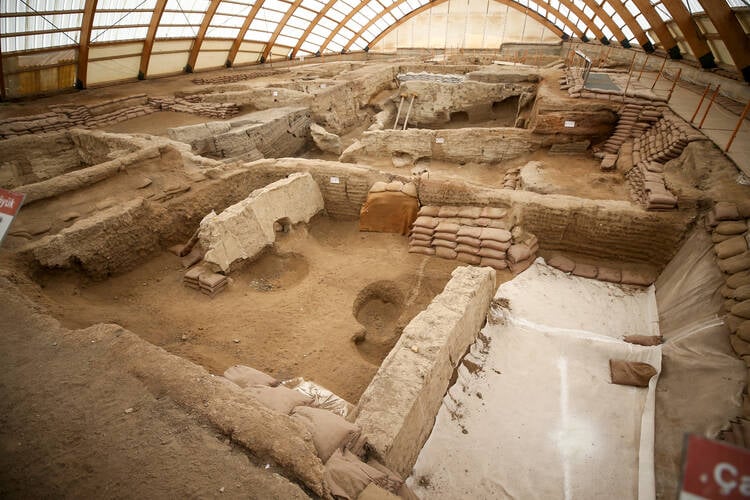Researchers believe that the leavened bread found at Turkey's Neolithic Çatalhöyük site is 8,600 years old, making it the oldest bread in the world.

University’s Science and Technology Research and Application Center (BİTAM)Archaeologists discovered this 8,600-year-old bread in Çatalhöyük.
Archaeologists recently discovered the remnants of an 8,600-year-old loaf of bread in Çatalhöyük, a Neolithic site in south-central Turkey. Now, the leavened bread has been identified as the oldest in the world.
Researchers are not only excited about the find itself, but also the development in technological capability it took to identify it.
Discovering The World’s Oldest Bread
Çatalhöyük is a UNESCO World Heritage Site in southern Anatolia. Researchers have long considered this site to be of remarkable importance, as it was among the first places in the world where urbanization occurred.
First settled in 7400 B.C.E. and rediscovered in 1958 C.E., Çatalhöyük was once home to approximately 8,000 people, and researchers have identified several adobe homes and artifacts they left behind.
Archaeologists first discovered the bread while excavating “Space 66,” a section of the Çatalhöyük site made up of adjacent adobe houses that can be accessed from doors in their roofs.
There, near a severely damaged oven structure, they uncovered a palm-shaped object made of wheat, barley, and pea seeds. Its proximity to the furnace indicated that the spongy artifact was likely some sort of food.
Researchers sent the curious object to Necmettin Erbakan University’s Science and Technology Research and Application Center (BİTAM) for analysis. There, the lab concluded that the artifact was leavened bread dating back to 6600 B.C.E.

Anadolu AgencyÇatalhöyük, Turkey. The Neolithic site where archaeologists discovered the bread.
Gaziantep University lecturer Salih Kavak, one of the researchers involved in the analysis, recalled receiving the artifact in a press release by Necmettin Erbakan University.
“I was very surprised when they brought it,” Kavak said. He suspected at the time that it might be “dough, bread, or an organic residue.”
BİTAM conducted a detailed examination of the bread and discovered air pockets and plant residues, strengthening the researchers’ assertions that they were dealing with an ancient sample of bread.
“I made a morphological diagnosis with the naked eye, then I immediately looked at the contents under the microscope,” Kavak explained. “The most exciting thing is that there are grain residues. There are ground and broken pieces of plants such as barley, wheat and peas. What we thought at first was, ‘I wonder if this is bread.’ It strengthened the possibility.”
Kavak added that a chemical analysis of the substance revealed signs that it was fermented, suggesting it had been mixed and prepared but never baked.
Rewriting The History Of Food
Prior to the finding at Çatalhöyük, historians believed the oldest leavened bread came from Ancient Egypt. But with this discovery, Turkish researchers are proud to recognize their site’s contributions to human history.
“We can say that this find in Çatalhöyük is the oldest bread in the world,” said Dr. Ali Umut Türkcan, a professor at Anadolu University and head of the Excavation Committee, according to Turkish media site Anadolu Agency. “It’s a miniature version of a loaf of bread. It hasn’t been baked in the oven but has fermented, preserving the starches. Such an example hasn’t existed until now.”
Türkcan explained that excavations at Çatalhöyük have also revealed some of the world’s earliest and best preserved textiles, wooden works, and wall paintings
“Çatalhöyük was already the center of many firsts,” Türkcan stated. “Konya and Turkey are very lucky in this sense.”
Researchers are also proud of the fact that they performed the analysis of the bread entirely in Turkey. Previously, researchers sent their findings abroad for proper review.
BİTAM’s Deputy Director, Yasin Ramazan Eker, emphasized BITAM’s capability to analyze archaeological artifacts, noting that they “could determine the chemical and physical structures of samples and interpret their significance.”
“With advanced technology, we could conduct these analyses at the BITAM central laboratory, leading to more accurate diagnoses,” Eker stated.
After reading about the discovery of the world’s oldest bread, discover the story of Göbekli Tepe, the 10,000-year-old temple in Turkey. Then, learn about the Methuselah tree, the oldest tree in the world.





